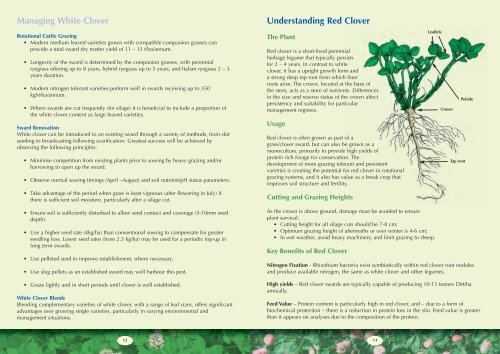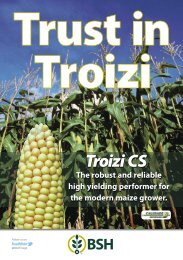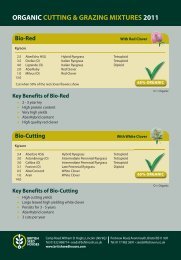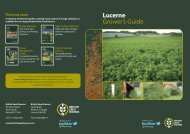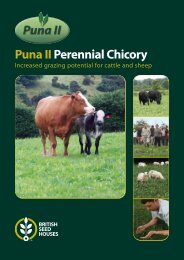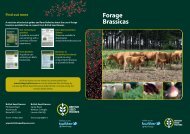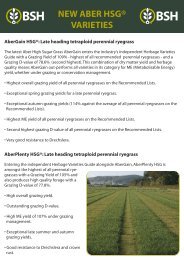Create successful ePaper yourself
Turn your PDF publications into a flip-book with our unique Google optimized e-Paper software.
Managing <strong>White</strong> <strong>Clover</strong><br />
Rotational Cattle Grazing<br />
• Modern medium leaved varieties grown with compatible companion grasses can<br />
provide a total sward dry matter yield of 11 – 13 t/ha/annum.<br />
• Longevity of the sward is determined by the companion grasses, with perennial<br />
ryegrass offering up to 8 years, hybrid ryegrass up to 5 years, and Italian ryegrass 2 – 3<br />
years duration.<br />
• Modern nitrogen tolerant varieties perform well in swards receiving up to 350<br />
kgN/ha/annum.<br />
• Where swards are cut frequently (for silage) it is beneficial to include a proportion of<br />
the white clover content as large leaved varieties.<br />
Sward Renovation<br />
<strong>White</strong> clover can be introduced to an existing sward through a variety of methods, from slot<br />
seeding to broadcasting following scarification. Greatest success will be achieved by<br />
observing the following principles:<br />
• Minimise competition from existing plants prior to sowing by heavy grazing and/or<br />
harrowing to open up the sward.<br />
• Observe normal sowing timings (April –August) and soil nutrient/pH status parameters.<br />
• Take advantage of the period when grass is least vigorous (after flowering in July) if<br />
there is sufficient soil moisture, particularly after a silage cut.<br />
Understanding Red <strong>Clover</strong><br />
The Plant<br />
Red clover is a short-lived perennial<br />
herbage legume that typically persists<br />
for 2 – 4 years. In contrast to white<br />
clover, it has a upright growth form and<br />
a strong deep tap root from which finer<br />
roots arise. The crown, located at the base of<br />
the stem, acts as a store of nutrients. Differences<br />
in the size and reserve status of the crown affect<br />
persistency and suitability for particular<br />
management regimes.<br />
Usage<br />
Red clover is often grown as part of a<br />
grass/clover sward, but can also be grown as a<br />
monoculture, primarily to provide high yields of<br />
protein rich forage for conservation. The<br />
development of more grazing tolerant and persistent<br />
varieties is creating the potential for red clover in rotational<br />
grazing systems, and it also has value as a break crop that<br />
improves soil structure and fertility.<br />
Cutting and Grazing Heights<br />
Leaflets<br />
Petiole<br />
Crown<br />
Tap root<br />
• Ensure soil is sufficiently disturbed to allow seed contact and coverage (5-10mm seed<br />
depth).<br />
• Use a higher seed rate (4kg/ha) than conventional sowing to compensate for greater<br />
seedling loss. Lower seed rates (from 2.5 kg/ha) may be used for a periodic top-up in<br />
long term swards.<br />
• Use pelleted seed to improve establishment, where necessary.<br />
• Use slug pellets as an established sward may well harbour this pest.<br />
• Graze lightly and in short periods until clover is well established.<br />
<strong>White</strong> <strong>Clover</strong> Blends<br />
Blending complementary varieties of white clover, with a range of leaf sizes, offers significant<br />
advantages over growing single varieties, particularly in varying environmental and<br />
management situations.<br />
As the crown is above ground, damage must be avoided to ensure<br />
plant survival:<br />
• Cutting height for all silage cuts should be 7-8 cm;<br />
• Optimum grazing height of aftermaths or over winter is 4-6 cm;<br />
• In wet weather, avoid heavy machinery, and limit grazing to sheep.<br />
Key Benefits of Red <strong>Clover</strong><br />
Nitrogen Fixation - Rhizobium bacteria exist symbiotically within red clover root nodules<br />
and produce available nitrogen, the same as white clover and other legumes.<br />
High yields – Red clover swards are typically capable of producing 10-15 tonnes DM/ha<br />
annually.<br />
Feed Value – Protein content is particularly high in red clover, and – due to a form of<br />
biochemical protection – there is a reduction in protein loss in the silo. Feed value is greater<br />
than it appears on analyses due to the composition of the protein.<br />
12 13


